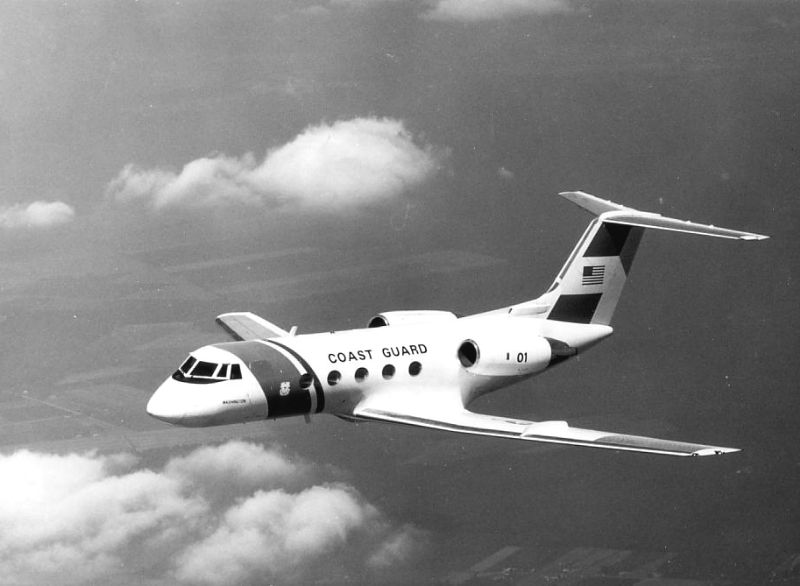
 |
 |
 |
 |
 |
 |
 |
 |
 |

One of the most successful members of the Gulfstream corporate aircraft family, the Gulfstream II is a Spey powered development of the original turboprop powered Gulfstream I.
The RollsRoyce Dart turboprop powered Gulfstream I proved to be quite successful as a large long range corporate transport, while the availability of an faster and more powerful turbojet powered model, the RollsRoyce Spey meant that a jet powered successor was a logical development. Grumman launched such an aircraft, named the Gulfstream II or G-II, in May 1965.
While based on the original Gulfstream I - the GII shares the same forward fuselage and cross section - there are more differences than similarities. The most obvious difference is the two rear mounted Spey axial flow turbojet engines, others include a new swept wing and tail. A similar size fuselage to the GI seats 10 in a typical executive configuration.
No prototype GII was built, instead the first to fly was a production standard aircraft, which first flew on October 2 1966. Certification and first production deliveries occurred in October and December 1967 respectively. By the end of production in 1979 a total of 256 aircraft were built.
The C-11 is a military modification of the commercial Gulfstream II aircraft. The Gulfstream VC-11A is used as a small transport by the Coast Guard. It is based on the twin engine Gulfstream that is used in commerical aviation.
The C-11A Shuttle Training Aircraft (STA) is a modified Grumman American Aviation-built Gulfstream II executive jet that was modified to simulate an orbiter's cockpit, motion and visual cues, and handling qualities. It is used by Shuttle flight crews to practice landing the orbiter. In flight, the STA duplicates the orbiter's atmospheric descent trajectory from approximately 35,000 feet altitude to landing on a runway. Although the STA is much lighter and smaller than the Space Shuttle, it simulates, with some trajectory following error, the aerodynamics of the Space Shuttle. The orbiter differs in at least one major aspect from conventional aircraft; it is unpowered during re-entry and landing so its high-speed glide must be perfectly executed the first time - there is no go- around capability. The orbiter touchdown speed is 213 to 226 miles (343 to 364 kilometers) per hour. There are two STAs, based in Houston.
The Huntsville-based Army Missile Defense and Space Technology Center [MDSTC] manages the High Altitude Observatory (HALO) program for BMDO. The HALO is an instrumented Gulfstream II-B optical data collection aircraft providing airborne collection of multispectral (spanning the ultraviolet through the longwave infrared), imaging (calibrated radiometric and photo documentary), optical signature data on targets of interest including reentry vehicles, missile plume phenomenology, and missile/target intercepts, and intercept debris characterization and kill assessment. The mobile test asset supports a variety of user organizations with sustaining funds provided by BMDO and augmented by user funds for specific missions activities.
Note: The G-II was the last Gulfstream plane to be built and produced by Grumman American, a subsidiary of the Grumman Corporation. Grumman American was formed after Grumman bought out American Aviation in 1972. The G-III project was launched by Grumman American, but soon afterwards Grumman American seperated from its parent company Grumman Aerospace and became Gulfstream Aerospace Corporation, which today builds and produces the Gulfstream corporate jets.
Powerplant: Two Rolls-Royce "Spey" Mk.511-8 turbofans
Wingspan: 68 ft 10 in (21.0 m)
Length: 79 ft 11 in (24.4 m)
Height: 7.4 m
Wing area: 73.7 sq. m
Empty weight: 17235 kg
Takeoff weight: 65,500 lbs
Max. speed: 588 mph (947 kph)
Climb rate: 25.6 m/s
Ceiling: 13100 m
Range: 3744 miles (6050 km)
Crew: 2-3
Payload: 12-19 passengers
 Manufacturer: Grumman
Manufacturer: Grumman